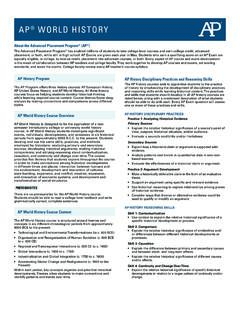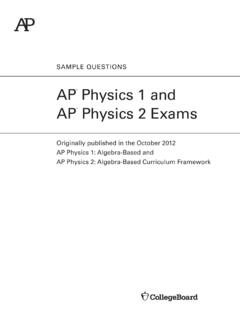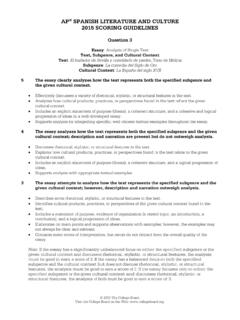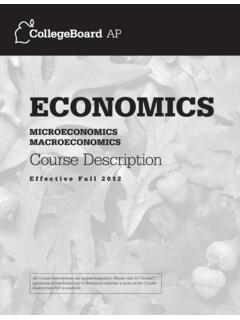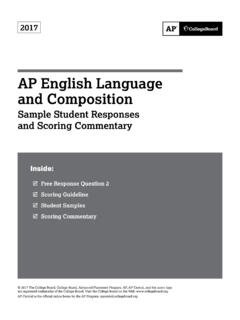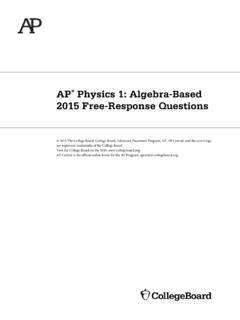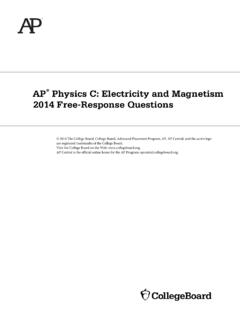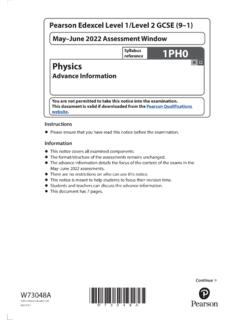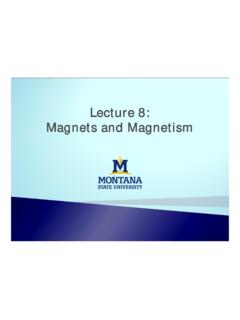Transcription of AP Physics C: Electricity and Magnetism 2015 Free …
1 AP Physics C: Electricity and Magnetism 2015 free -Response Questions 2015 The College Board. College Board, Advanced Placement Program, AP, AP Central, and the acorn logo are registered trademarks of the College Board. Visit the College Board on the Web: AP Central is the official online home for the AP Program: ADVANCED PLACEMENT Physics C TABLE OF INFORMATION. CONSTANTS AND CONVERSION FACTORS. Proton mass, m p 10 27 kg Electron charge magnitude, e 10 19 C. Neutron mass, mn 10 27 kg 1 electron volt, 1 eV 10 19 J. Electron mass, me 10 31 kg Speed of light, c 108 m s Universal gravitational 10 11 N<m 2 kg 2. Avogadro's number, N 0 10 23 mol 1 G. constant, Acceleration due to gravity Universal gas constant, R J (mol <K). at Earth's surface, g m s2. Boltzmann's constant, k B 10 23 J K.
2 1 unified atomic mass unit, 1u 10 27 kg 931 MeV c 2. Planck's constant, h 10 34 J <s 10 15 eV <s hc 10 25 J <m 103 eV < nm Vacuum permittivity, e0 10 12 C2 N < m 2. Coulomb's law constant, k 1 4 pe0 109 N< m 2 C2. Vacuum permeability, m0 4 p 10 7 (T <m) A. Magnetic constant, k m0 4 p 1 10 7 (T< m) A. 1 atmosphere pressure, 1 atm 105 N m 2 105 Pa meter, m mole, mol watt, W farad, F. kilogram, kg hertz, Hz coulomb, C tesla, T. UNIT second, s newton, N volt, V degree Celsius, C. SYMBOLS. ampere, A pascal, Pa ohm, W electron volt, eV. kelvin, K joule, J henry, H. PREFIXES VALUES OF TRIGONOMETRIC FUNCTIONS FOR COMMON ANGLES. D. Factor Prefix Symbol q 0 30D 37D 45D 53D 60D 90D. 109 giga G sin q 0 12 35 2 2 45 3 2 1. 106 mega M cos q 1 3 2 45 2 2 35 12 0. 103 kilo k tan q 0 3 3 34 1 43 3.
3 10 2 centi c 10 3 milli m The following assumptions are used in this exam. 10 6 micro m I. The frame of reference of any problem is inertial unless otherwise stated. 10 9 nano n II. The direction of current is the direction in which positive charges 10 12 pico p would drift. III. The electric potential is zero at an infinite distance from an isolated point charge. IV. All batteries and meters are ideal unless otherwise stated. V. Edge effects for the electric field of a parallel plate capacitor are negligible unless otherwise stated. -2- ADVANCED PLACEMENT Physics C EQUATIONS. MECHANICS Electricity AND Magnetism . x x 0 a x t a = acceleration 1 q1q2 A = area E= energy FE B = magnetic field 1 2 4pe0 r 2. x x0 x 0 t at F = force C = capacitance 2 x . f = frequency FE d = distance x2 2.
4 X 0 2 a x x x0 E. h = height q E = electric field I = rotational inertia = emf F Fnet Q. E dA. a J = impulse F = force m m e0. K = kinetic energy I = current k = spring constant J = current density dp dV. F = length Ex L = inductance dt dx L = angular momentum = length . J m= mass F dt Dp P = power DV E dr n = number of loops of wire per unit length p = momentum N = number of charge carriers p mv 1 q . r = radius or distance V. 4pe0 rii P =. per unit volume power T = period i Ff m FN. t = time Q = charge 1 q1q2. U= potential energy UE qV q = point charge DE W F dr v = velocity or speed 4pe0 r R = resistance 1 2 W= work done on a system r = radius or distance K m Q. 2 x = position DV t = time C. m = coefficient of friction U = potential or stored energy dE k e0 A V= electric potential P q = angle C.
5 Dt d t = torque v = velocity or speed w = angular speed r = resistivity P F v Cp Ci a = angular acceleration i F = flux DUg mg Dh f = phase angle k = dielectric constant 1 1 . Fs k D x Cs C FM qv B. 2 i i ac w2r . r Us 1. k Dx 2. I. dQ B d m0 I. 2 dt t r F . x xmax cos( wt f m0 I d r . 1. QDV. 1. C DV 2 dB. t t net UC. 2 2. 4p r 2. a 2p 1. I I T r . 2 2. w f R. A. F I d B. I r dm mr Ts 2p m Bs m0 nI. k E rJ. mi xi . xcm mi Tp 2p I Nevd A FB B dA. g rw DV d FB.. Gm1m2. I. R. e E d . dt FG. L r p Iw r2 dI. Rs Ri e L. Gm1m2 i dt 1 2 UG . K Iw r 2 1 1 1 2. R UL LI. Rp i i 2. w w0 at 1 2 P I DV. q q0 w0 t at 2. -3- ADVANCED PLACEMENT Physics C EQUATIONS. GEOMETRY AND TRIGONOMETRY CALCULUS. Rectangle A = area df d f du A bh C = circumference dx du dx V = volume Triangle d n S = surface area x nx n 1.)
6 1 dx A bh b = base 2 d ax h = height e aeax Circle = length dx A pr2 w = width d 1. ln ax r = radius dx x C 2p r s = arc length d s rq q = angle dx >sin ax @ a cos ax Rectangular Solid d V wh dx >cos ax @ a sin ax Cylinder s n 1 n 1. V pr . 2. r x dx n 1. x , n 1. q ax 1 ax S 2p r 2p r 2. e dx e a Sphere dx 4 3 x a ln x a V pr 3. 1. S 4p r 2 cos ax dx a sin ax 1. Right Triangle sin ax dx cos ax a a 2 b2 c2. VECTOR PRODUCTS. a . sin q c A B AB cos q c . b a A B AB sin q cos q c q 90 . b a tan q b -4- 2015 AP Physics C: Electricity AND Magnetism free -RESPONSE QUESTIONS. Physics C: Electricity AND Magnetism . SECTION II. Time 45 minutes 3 Questions Directions: Answer all three questions. The suggested time is about 15 minutes for answering each of the questions, which are worth 15 points each.
7 The parts within a question may not have equal weight. Show all your work in this booklet in the spaces provided after each part. E& A parallel-plate capacitor is constructed of two parallel metal plates, each with area A and separated by a distance D. The plates of the capacitor are each given a charge of magnitude Q, as shown in the figure above. Ignore edge effects. (a). i. On the figure above, draw an arrow to indicate the direction of the electric field between the plates. ii. On the figure above, draw an appropriate Gaussian surface that will be used to derive an expression for the magnitude of the electric field E between the plates. iii. Using Gauss's law and the Gaussian surface from part (a)-ii, derive an expression for the magnitude of the electric field E between the plates.
8 Express your answer in terms of A, D, Q, and physical constants, as appropriate. The space between the plates is now filled with a dielectric material that is engineered so that its dielectric constant varies with the distance from the bottom plate to the top plate, defined by the x-axis indicated in the . diagram above. As a result, the electric field between the plates is given by E . Q i , where k is a x D 0. e0 k 0 e A. positive constant. Express all algebraic answers to the remaining parts in terms of A, D, Q, k0 , x, and physical constants, as appropriate. (b) Determine an expression for the dielectric constant k as a function of x. 2015 The College Board. Visit the College Board on the Web: GO ON TO THE NEXT PAGE. -5- 2015 AP Physics C: Electricity AND Magnetism free -RESPONSE QUESTIONS.
9 (c). i. Write, but do NOT solve, an equation that could be used to determine the potential difference V. between the plates of the capacitor. ii. Using the equation from part (c)-i, derive an expression for the potential difference VD V0 , where VD is the potential of the top plate and V0 is the potential of the bottom plate. (d) Determine the capacitance of the capacitor. (e) The energy stored in the capacitor that has a varying dielectric is UV . A second capacitor that has a constant dielectric of value k0 is also given a charge Q. The energy stored in the second capacitor is UC . How do the values of UV and UC compare? ____ UV UC ____ UV ! UC ____ UV UC. Justify your answer. 2015 The College Board. Visit the College Board on the Web: GO ON TO THE NEXT PAGE.
10 -6- 2015 AP Physics C: Electricity AND Magnetism free -RESPONSE QUESTIONS. E& A student performs an experiment to determine the emf e and internal resistance r of a given battery. The student connects the battery in series to a variable resistance R, with a voltmeter across the variable resistor, as shown in the figure above, and measures the voltmeter reading V as a function of the resistance R. The data are shown in the table below. Trial # Resistance W Voltage V 1R 1W 1V 1V. 1 2 3 4 5 6 10 (a). i. Derive an expression for the measured voltage V. Express your answer in terms of R, e, r, and physical constants, as appropriate. ii. Rewrite your expression from part (a)-i to express 1 V as a function of 1 R . 2015 The College Board. Visit the College Board on the Web: GO ON TO THE NEXT PAGE.
